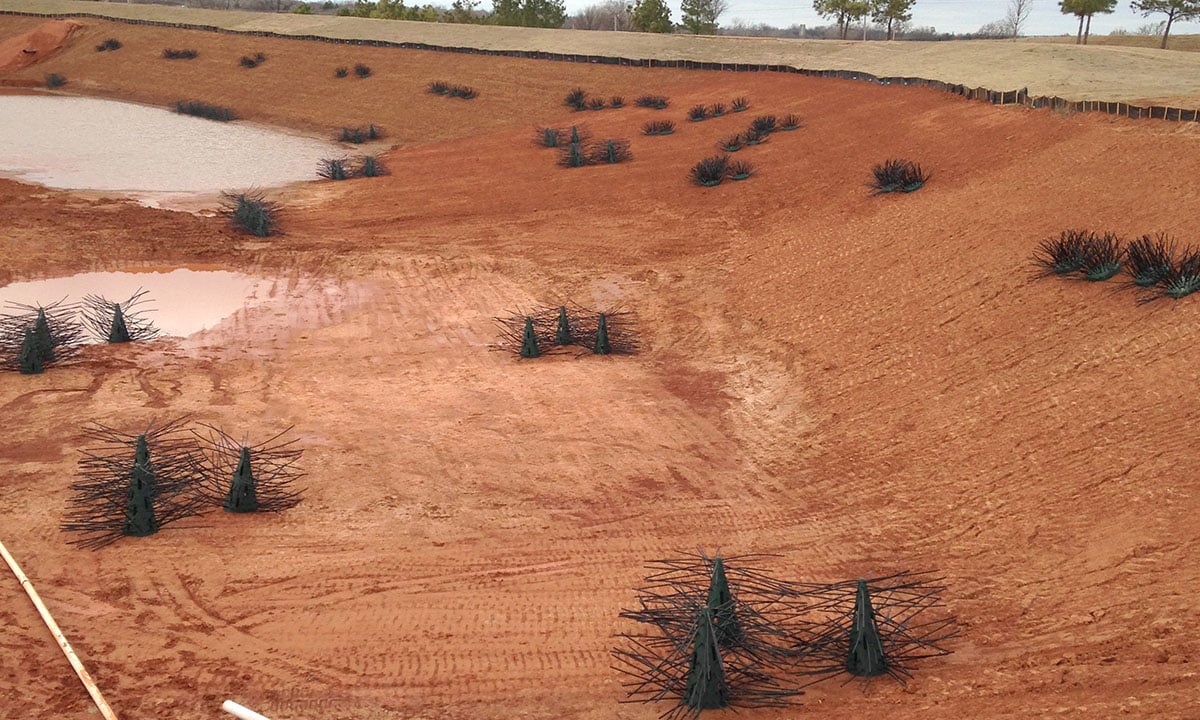Your new pond has just been completed and now you’re just waiting on some rain to fill it to full pool. However, before the rain comes, it would be wise to consider adding habitat while the pond is still dry.
Habitat can be added at any time, but sometimes it is easier to place the habitat in more precise locations while the pond is waiting to fill. This is especially true of deeper locations if you do not have a boat. If this is the case, you should really consider one of Pond King’s pontoon boats. Alas, boats are a topic for another day.
Why Ponds Need Artificial Fish Habitat
Why do you need habitat in the first place? Fish of all species need cover for various reasons at different stages of their lives: to hide, to eat, to hunt. A majority of ponds offer almost nothing in the way of complex structural habitat, and natural vegetation can be difficult to control. Artificial fish habitat is a great solution to get your fish the cover they need.
Pond King’s Fish Habitat is Long-Lasting
Pond King Honey Hole artificial habitat doesn’t grow, rot, or release unknown toxins. In simple terms, the habitat will be there forever.

Downed trees and shrubs make great natural habitat, but over time they rot and lose a majority of their benefit, thus needing to be replaced periodically. They also can be thieves of your fishing lures!
Pond King's artificial habitat line is made with high density polyethylene, and if your lure happens to get snagged in one of the limbs, you can "pop" your line, and your lure will be freed.
What Habitat Options Does Pond King Offer?

As you can tell from the figure above, Pond King offers a wide variety of artificial habitat to handle all of your needs. Each piece of habitat has been designed for a specific purpose at different stages of a fish’s life. The depth of the pond in different areas is a huge factor in the placement of the habitat.
See the full Habitat At a Glance Chart.
It wouldn’t make much sense to place a Honey Hole Reed in 3’ of water when it is 8’ tall. It would stick out and not provide the adequate cover for your fish. If a small portion of the habitat sticks out of the water that is fine, but you want a majority of it under water to get the full benefit of the structure. Placing the structures in clusters of 2 or 3 can also help enhance the effectiveness of the structures.
Is it Ok to Have a Pond with Sparse Cover or Fish Habitat?
Some habitat is better than no habitat at all. Don’t get so worked up on finding an exact placement for each piece. Each piece of habitat has a guide as to its main purpose: promote baitfish production and survival, provide cover to intermediate sized fishes, primarily attract gamefish, and attract fishes that suspend in deep water. The recommended depth is also included in the chart.
Where is the best place to position artificial habitat in my pond?
The habitat for spawning should be placed in areas where the water will still be at least 2 feet deep during the spring to allow fish to have plenty of room to do their business without being predated easily. Any Honey Hole Nursery can be placed around feeders and areas you want to protect juvenile fish from predators.
The Honey Hole Shrub and Tree provide excellent cover for bluegill, shiners and other baitfish and also provide ambush opportunities for bass and crappie in your waterway.
The Honey Hole Grass, Brush and Reeds, when placed in groups, allow for bass to have edge habitat in mid-to-deeper waters.

The Honey Hole structures allow fish of several size classes to find refuge in deep waters drawing bass out from the shallows to more open water.
The Dock Dropper is a great way to add structure to docks on any private or public waterways and attract baitifish and crappie to their new habitat!
- Honey Hole Spawning Discs 2-4 ft
- Honey Hole Nursery 2-3 ft
- Honey Hole Mega Nursery 4-5 ft
- Honey Hole Shrub 3-6 ft
- Honey Hole Grass 4-6 ft
- Honey Hole Tree 6-10 ft
- Honey Hole Brush 7-10 ft
- Honey Hole Reeds 10-12 ft
- The Honey Hole 15+ ft
- Dock Dropper 15+
Based on this info, you will be able to place the habitat in beneficial locations to help insure the long-term success of your pond.
Contact Pond King for Fish Habitat Management
Building a mixture of both soft, complex, aquatic vegetation and hard structural cover will provide both protection from predators. Your pond’s fish will have usable habitat throughout the entire year. The team at Pond King can help you decide what types and how much fish habitat you need for your pond. Call or contact us with questions about professional pond management.
Happy Fishing, and we'll See ya'll Down at the Pond!




